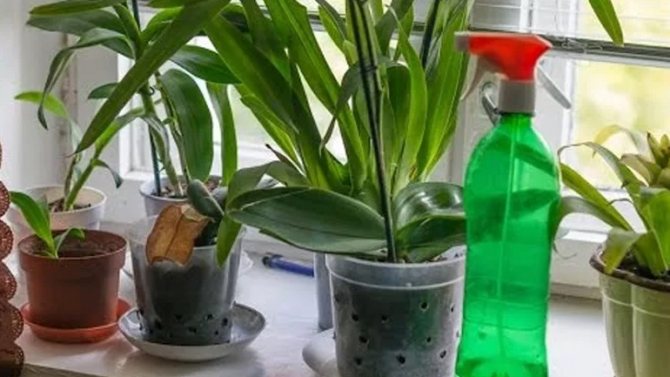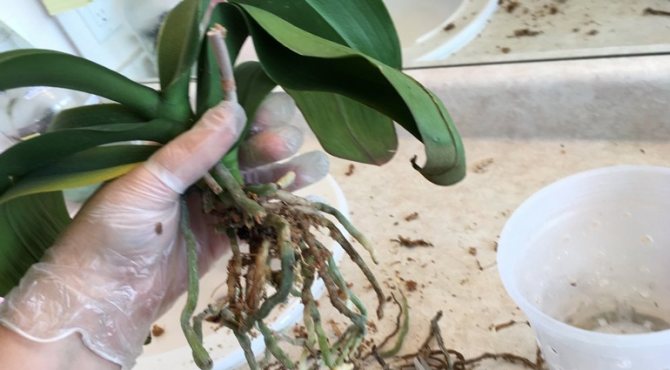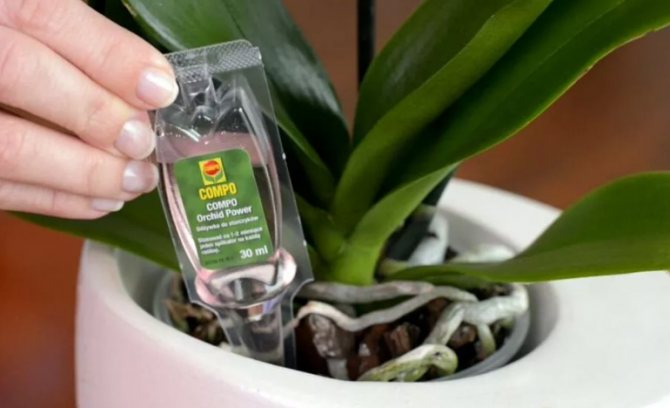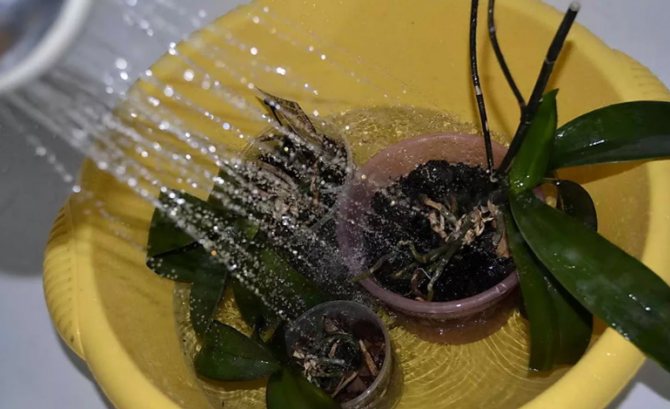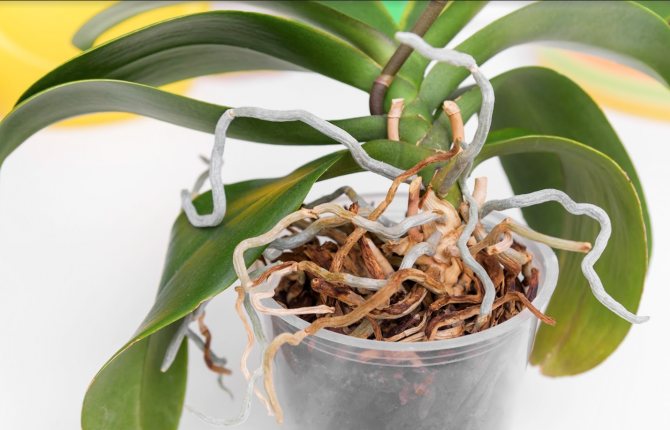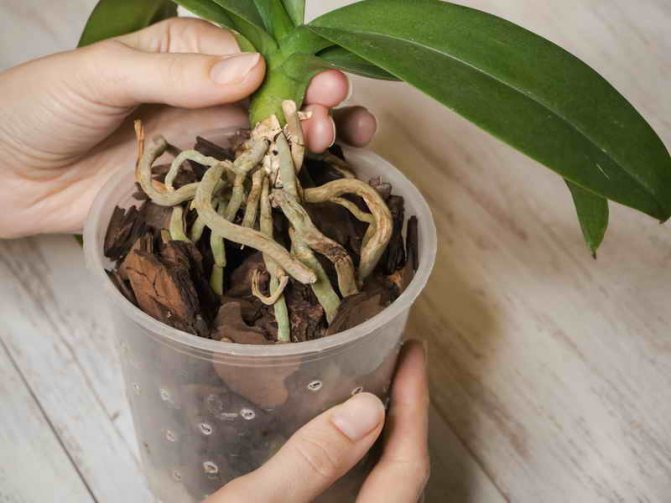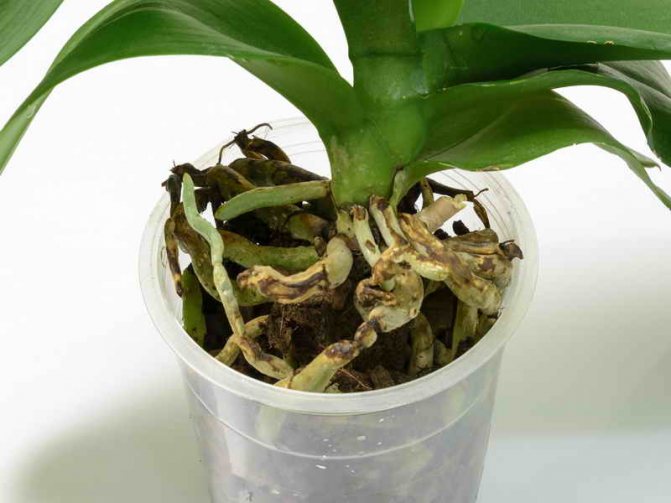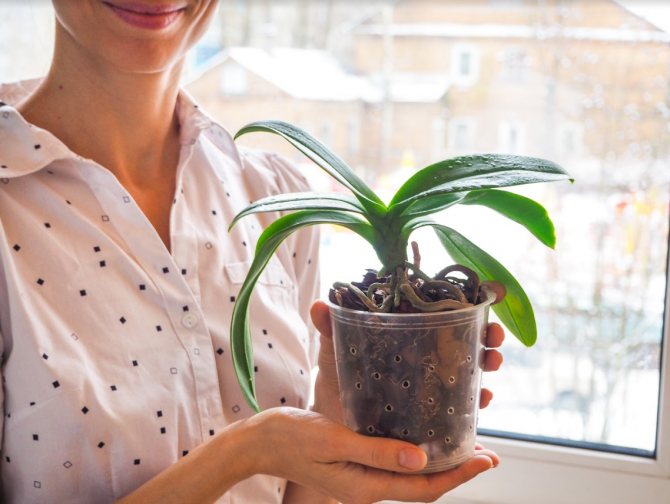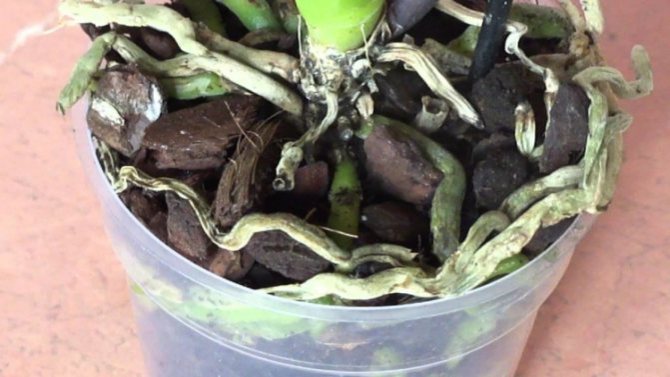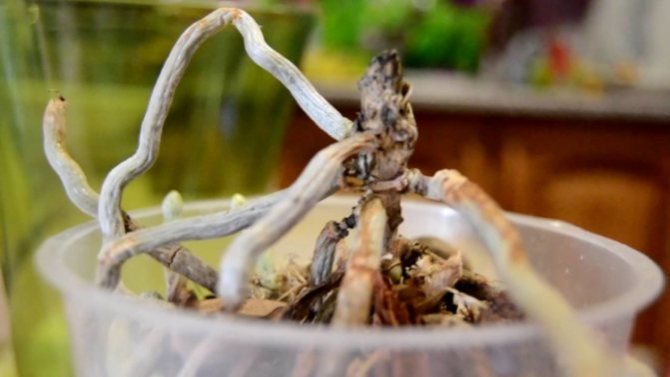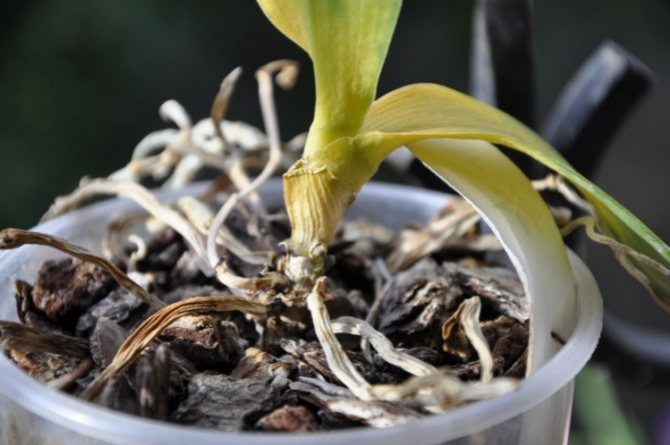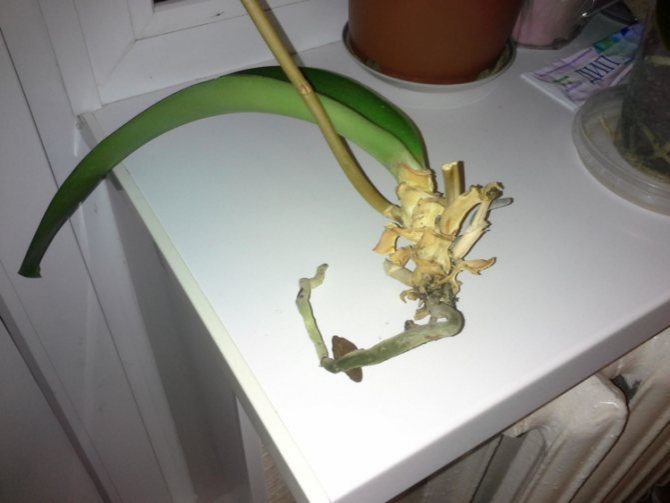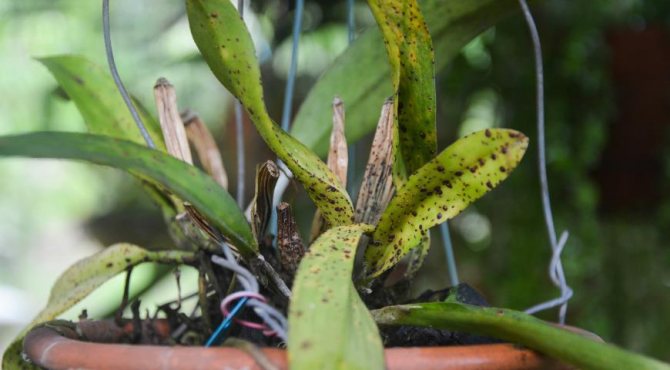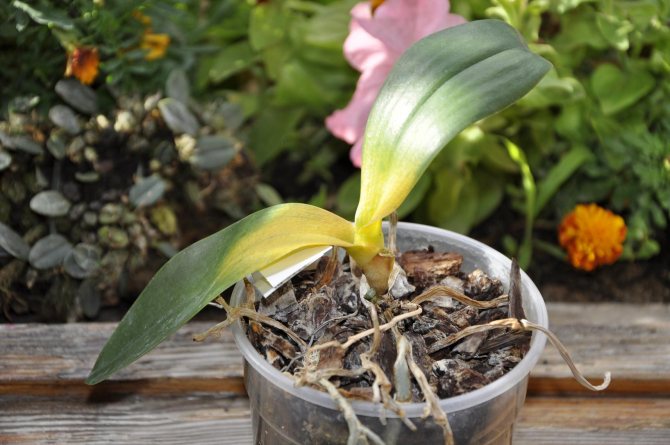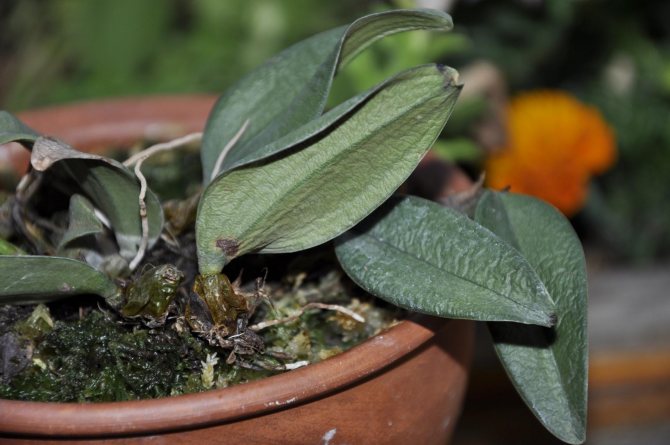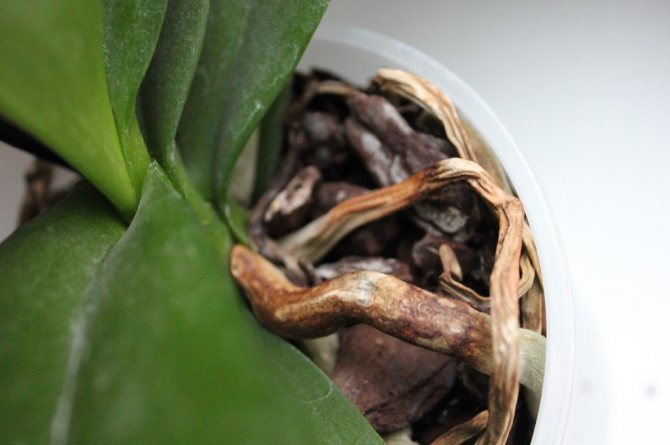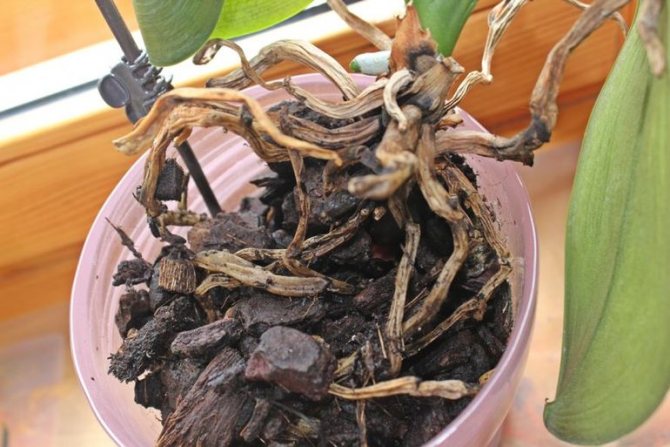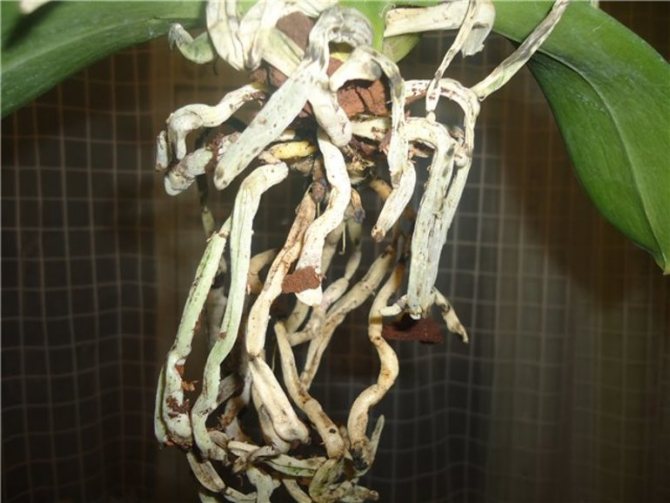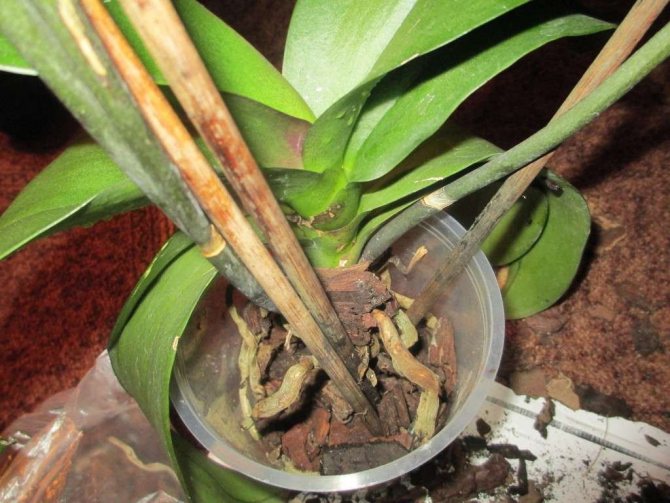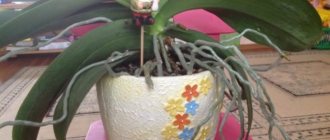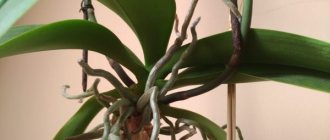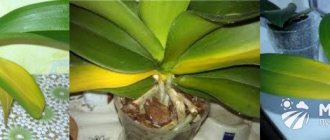Orchid is a very beautiful indoor flower that growers love. He earned recognition for both long-lasting flowering and luxurious flowers. However, in order for the phalaenopsis to bloom and not get sick, strict adherence to a number of care rules is required. A very common problem when growing this plant is the poor condition of the root system. There may be several reasons why the roots of orchids dry, but it is always an alarming signal and requires an immediate solution to the problem.
In the article we will talk about why the roots of the orchid dry, what to do if this has already happened, and how to revive the orchid after what happened.
The best varieties of orchids
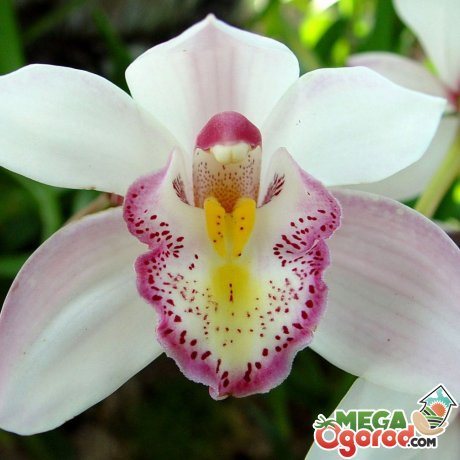
The orchid is a delicate creature of various shapes and incredible shades. It differs not only in external qualities, but also in size:
- The first group is represented by shrubs with flower stalks in a horizontal position. Over time, the sprouts are able to transform into pseudobulbs, which accumulate a significant amount of moisture and useful trace elements.
Monopodial plants are orchids, with a pronounced main peduncle, on which a large number of inflorescences are located. They gradually open up and completely fill the entire space of the arrow.
Each type of exotic bush is picky about care, growth and cultivation characteristics. The following are the best varieties of orchids that are popular among the population:
- Aganizia is a rare plant, practically not grown indoors. It differs from others in the unusual shapes of leaves and peduncles.
- Angrekum Leonis - has a pleasant, not persistent aroma, produces flowers of interesting shape, large size. The inflorescences have pastel colors, up to a matte ivory shade.
- Phalaenopsis is the most common exotic in Russia; it lives well in indoor conditions. With quality care, it grows for 6-7 years. It does not have a specific dormant period; under favorable circumstances, it blooms for 6-9 months.
- Wanda - like Phalaenopsis, is widespread. Its stem can stretch up to 2 meters, and the root system can expand in breadth. It does not differ in long flowering - the inflorescences last for 1, -3 months. Flowers, especially at night, give off a pleasant, delicate aroma with a caramel flavor.
- Cattleya - can be both miniature, even dwarf, and huge. It is impossible to buy this type in the store, only in the case of a special order. And it's not a fact that an original exotic plant will come, and not a hybrid.
- Dendrobium is a diverse species of shrubs. Has unusual colors and shapes of flowers. Inflorescences reach 5-8 cm in diameter. With quality care, it has the ability to bloom 2 times a year - in the summer months and winter days.
Thus, the orchid has many types. In living nature, there are more than 70 types of its representatives. But not all of them can grow in temperate climates, they do not have the opportunity to grow at home.
Natural aging of orchid roots
In its development, the roots of orchids go through several stages: growth, branching, dormancy, dying off.Like leaves, roots do not last forever and age gradually. At old roots, the parenchyma dies off, and visually this is perceived as drying out.
“The withering away of old roots does not happen overnight. This is a long process, and the root remains viable for a long time. Often old dying roots begin to branch out. Therefore, there is no need to rush to trim them. "
O. Stern, landscaper, collector of epiphytic plants
The lifespan of each individual root of an orchid is 2-3 years. Transplants are performed at about the same frequency. Therefore, during this procedure, you need to do the following:
- examine the roots and find old ones that have begun to die off;
- cut off completely dried, blackened or browned areas on them;
- areas that have dried up, but retained the gray color, leave them - there is a possibility that branches of young roots will go from them.
It is not difficult to understand that the roots do not get sick, but that they are aging. If the bulk of the root system has a healthy appearance, the plant is not depressed, the leaves retain a good turgor, do not have yellow spots, then the reasons for the drying out of individual roots are a natural process.
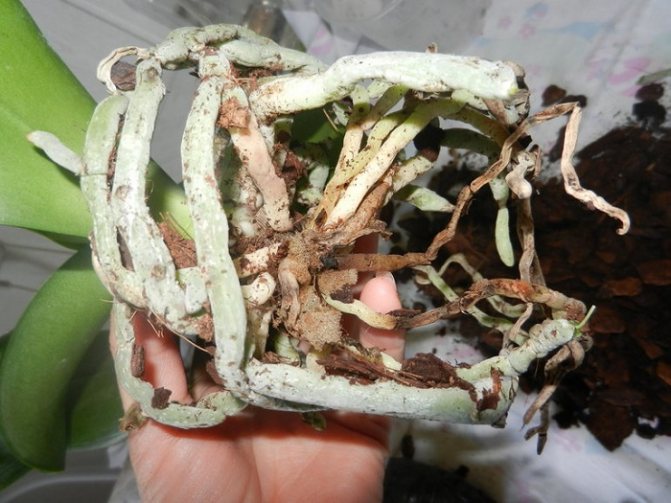

A healthy orchid has no more than two or three aging roots. If they are completely dry or, conversely, have begun to rot slightly, they are removed with scissors, and the cut is sprinkled with ground cinnamon and dried.
Photo
The photo shows what dried roots look like.
Solving the problem of drying out orchid roots
Having determined the reason for the drying of the roots, you can begin to solve it:
| Cause | Decision |
| Prolonged drought | Pruning completely dried roots, keeping them semi-dry. Submerge the remaining roots in water for 20 minutes. After extraction - planting in fresh soil, lined with moist sphagnum on top. Placing the pot on a pallet with important expanded clay. Daily spraying. |
| Chronic waterlogging | Pruning decayed roots, keeping them viable. Daily air drying of the orchid. Placing the plant in an intensive care greenhouse to grow new roots. |
| Fertilizer burn | Transplant into a clean substrate with thorough rinsing of the roots and pruning of the dead. Temporary cessation of feeding. Replacing fertilizer with a special one. |
| Old substrate or small container | Transplant into a new substrate and a slightly larger pot with pruning of dead roots. |
To avoid drying out of the roots, in the future, it is necessary to strictly observe the requirements of orchids for soil moisture and fertilizing, as well as replant plants on time.
Testimonials
“I love orchids very much, I have a small collection at home. At first, I treated the white bloom with fungicides, but I noticed that it does not always help. I even thought it was a non-fungal infection, I tried to fight with bactericidal drugs ... As a result, I learned to fight in a complex way. And from my own experience I realized that it is better to underfill a little water than to pour it, and it is necessary to water it, after waiting for the soil to dry. True, while the experience came, several orchids died. "
Prevention of the appearance of new aerial roots
Preventing the excessive appearance of aerial roots in an orchid is quite simple. To do this, you need to perform the following actions:
- adjust the irrigation system, avoiding overflow or drying out of the soil;
- add lighting;
- transplant the plant into a larger pot;
- loosen the knocked down soil.
Do not be afraid of buying a phalaenopsis, considering caring for it as a difficult science. Proper watering, abandonment of colored pots in favor of transparent plastic pots that promote root photosynthesis will certainly do the trick, and the plant will repeatedly delight its owners with lush flowering.
What to do for rescue and home care
There are a number of main reasons why all the roots have dried up, namely from what the root system died from above and below.Find out all the nuances that will help you cope with the problem and what needs to be done with dried roots.
Hard water burn
Aerial roots are mainly affected. Orchids are hardy plants. The flower functions at the expense of the internal root system. Soon, healthy kidneys grow on their own.
Water for irrigation should be soft.
There are several ways to soften water:
- Filtration. It is important to choose the right filter and cartridge, otherwise there will be no effect. They must be special to soften water. The method is expensive, but provides the maximum result.
- Add wood ash or fresh peat. 100 grams of peat per 10 liters of water. The ash should be exactly wood 3 grams per liter of water.
Fertilizer burn
- Start the treatment by soaking the roots and neck in clean water. Daily up to 1.5-2.5 hours. Repeat the procedure until new kidneys appear.
- Then transplant the flower into another substrate without fertilizers, after cutting off the affected roots.
Use half of the recommended dose of fertilizers, and universal fertilizers - three times less.
Causes of drying out of the root system
To understand what exactly is causing the problem, it is worth remembering the natural growing conditions of orchids. The homeland of the most beautiful species is the tropics with extreme humidity. Providing such a climate in an apartment or house is not easy. In addition, unlike most indoor flowers, the exotic beauty does not grow in the ground, but is attached to the branches and trunks of trees. Hence the main difficulties of leaving, which lead to damage to the root system:
- Insufficient moisture... With a slight degree of its shortage, drying of the aerial roots is noted. Although this does not affect the appearance of the orchid, it lacks some of the nutrients, which reduces flowering and lengthens the period of bud formation.
Another common occurrence is improper irrigation technology. The flower grower, following the rule, do not pour water into the orchid outlet, moistens the soil only around the perimeter of the pot. As a result, the central part of the roots may dry out. To prevent this from happening, the flower is watered from a watering can, directing the stream to the base of the growth and slightly lifting the leaves.
- Excess water... Many orchid enthusiasts over-water in an effort to maintain high levels of humidity. The abundance of moisture is fraught with more serious problems - the root atrophies, gradually the plant begins to rot, fungal plaque and infections appear, which will soon infect other indoor flowers.
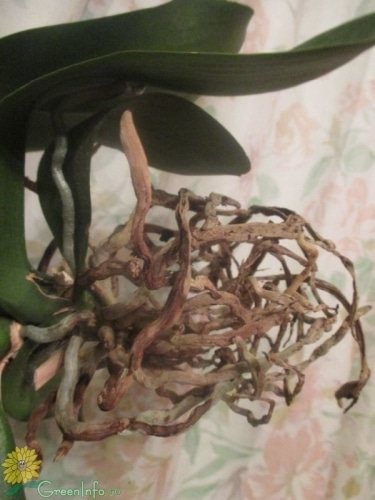

Along with inappropriate humidity, other care errors can also cause the roots of an orchid to dry:
- improperly selected pot (lack of space leads to interlacing of roots and the gradual displacement of old layers with new ones, as a result of which the root dries up in places);
- inappropriate temperature regime and changes are prerequisites for the development of diseases, the particular signs of which are drying orchid roots;
- poor-quality soil leads to a deterioration in the aeration of the roots, and also hinders the access of nutrients, as a result of which the underground part dries up (it must include 1/3 of moss, 1/3 of a mix of charcoal and bark plus perlite);
- watering and spraying with too hard water (so that the orchid does not dry out, the water must be boiled and defended before use);
- improperly selected fertilizer - an excess of nitrogen, phosphorus, potassium and other minerals causes a chemical burn of the roots, as a result of which they lose their ability to absorb water, necessary trace elements and dry out.
Having found one or two dry roots on an orchid, you should not immediately start to panic, it does not dry out. If in general the indoor flower is beautiful and elastic, the reason for the appearance of suspicious areas may be associated with the aging process of the roots. In this case, there is a natural renewal of obsolete organs. This process is not dangerous for the pet.
The main reasons for drying
Now as for why the stems of plants dry. There may be the following reasons for this:
- lack of moisture;
- parasite attack;
- fertilizer burns;
- diseases.
Let's consider what other reasons for drying are.
Water scarcity
This reason can be called the main one. Drought is harmful to flowers. When they lack water, cells stop dividing. As a result, this leads to their death. The lower part of the flower gradually dies off.
You can understand that the plant does not have enough moisture by the tip of the rhizome. It should be light green. If you see that the tip is completely dry, it can no longer be saved, so you will have to trim it. You can cut off a piece of the rod if it is not completely dry.
Also pay attention to the following signs indicating a lack of moisture: darkening of the root, a decrease in its thickness and a change in structure. To understand how dry the shoot is, you can visually or by touch.
Watering with hard water
Do not forget that the limbs of the plants are delicate. They are protected from mechanical damage by the earth, but they are powerless against chemical attack. In nature, plants receive moisture from soft rains or melting snows. And gardeners water the flowers with tap water, which can be harsh on them. In order not to burn the plants, water them with settled water, and not directly from the tap.
Chemical burns with fertilizer salts
If you are feeding an orchid, make sure that the composition is not concentrated. In this way, you will be able to avoid burns. You can minimize the harm of feeding by reducing the recommended dose of the agent.
Do not forget that you can only fertilize the lower part of the plants after abundant watering. This will prevent dryness of the upper roots.


Chemical burns with fertilizer salts lead to drying out of the root system
Root trauma
Despite the fact that the soil protects the plant from mechanical damage, it will not save it from rhizome bending or breaking. Therefore, you need to be extremely careful with the orchid, since careless actions lead to its death.
Infectious diseases
Such ailments are provoked by fungi and other microorganisms. After that, the flower rots and then dries. You can avoid such troubles through regular processing of phalaenopsis and preventive measures for infections.
When can a plant be no longer saved?
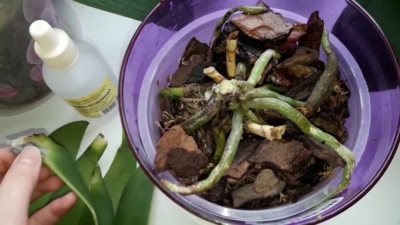

If, upon examination, there is not a single leaf on the orchid, it is completely without roots or they are severely damaged by rot and then you should not despair. The flower can be reanimated at any stage. You just need to choose the right treatment.
If all the roots of the orchid are dried, you need to treat the root collar with a root root and place it in moss or sphagnum. Moisten regularly with water. After the appearance of at least five roots, transplant the substrate.
What does it mean if the roots dry?
If the roots of an orchid dry in a pot, gradually losing turgor and becoming empty, then first of all it is necessary to regulate the watering of the plant. Usually, prolonged soaking of the flower in water every 7-10 days changes the situation.
This will not work with air roots, because you will not be able to soak them. Some lovers use regular spraying, not knowing that such a measure is quite dangerous, because if water gets into the phalaenopsis outlet, then the risk of decay of the root collar increases.
Keeping orchids in a well-ventilated area or in an open space will help change everything, in which they will have time to dry completely after spraying or showering. If this is not possible, then you will have to purchase an air humidifier and sphagnum moss, which is laid on top of the woody soil of the flower and is regularly spilled along the edge, providing the air roots with the same cherished moisture.
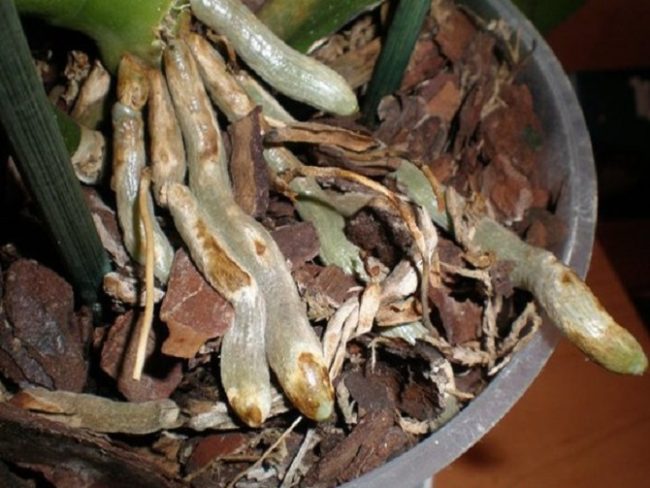

Preventing re-drying
- A visual inspection of the orchid should be carried out constantly.
- Observe the microclimatic conditions in the room: temperature during the day - + 23⁰C, and at night - + 16⁰C. At home, it is better to organize a daily drop within 7 degrees on a window where there is natural natural cooling of the glass and ventilation.
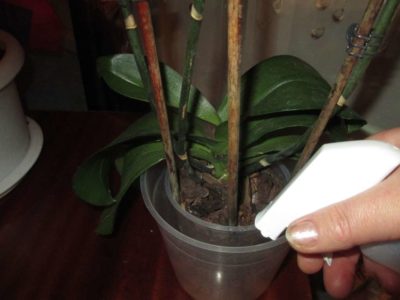

It is necessary to properly water the plant.- Saturate only the bark of the substrate with moisture; there should be no water in the pan. Use soft filtered water for irrigation.
- Plant the plant in transparent containers so as not to impede the penetration of air and light to the roots.
- It is important to choose your own method of watering: some growers just do watering, others use a shower heated to plus thirty to thirty-five degrees, and some put it on a water pillow.
- Less artificially interfere with the natural life cycle of the plant. For reproduction, the orchid needs to bloom, and then rest.
Preventive measures
Preventing dryness in the underground part of the plant is easier than restoring its health. Therefore, in order to avoid drying out, you need to organize suitable conditions for the flower:
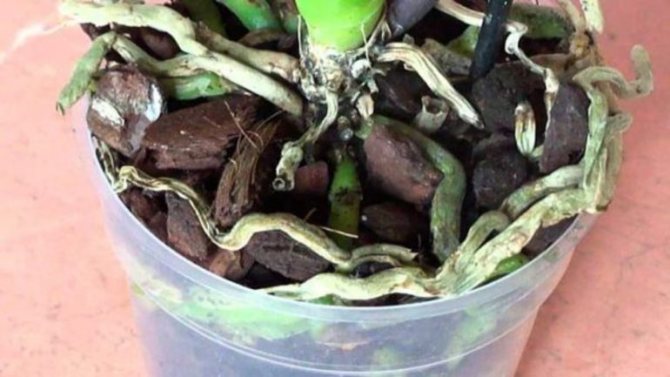

- Watering. The orchid should be watered no more than once a week. You can determine the need for this procedure by the presence of condensation in the pot. If there are drops of water on the walls of the container, then the flower does not need watering. In addition, the substrate must have time to dry, which is easy to determine by simply touching it.
- Humidity and optimum temperature. A native of tropical forests is very sensitive to any changes in temperature, and therefore, creating suitable growing conditions, one must proceed from the conditions under which the flower grows in nature. At night, the air temperature should not fall below 18 ° C, and during the day it should rise above 28 ° C. During the winter months, when the indoor air becomes too dry, a tray of water should be placed next to the plant.
- Pot. When choosing a container, you need to take into account the size of the orchid variety. If the pot is too small, the roots of the flower will begin to dry out. If it turns out to be too large, then the root system will rot.
How to revive an orchid?
In order to understand how to resurrect a dying plant, it is necessary to understand the factors of the problems. Oftentimes, improper care is to blame for the rotting roots. The orchid loves diffused light. Very often, difficulties with the root system in orchids begin in the autumn-winter period. Therefore, from September to March, you need to take extremely close care of the plants. If there is a lack of lighting, it is worth using additional lighting and phytolamps (the figure below shows a flower that did not have enough light):
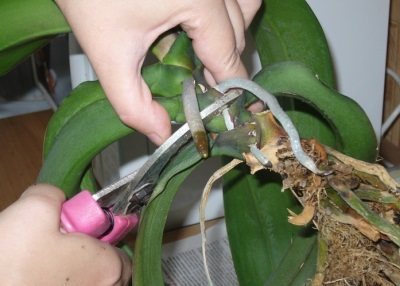

On a note!
If there is little light, the plant goes into a kind of hibernation.
It falls asleep and stops drawing water from the pot. As a result, it turns out that the liquid is absorbed into the upper layers of the root system, but does not flow to the leaves. There is stagnation of water - the flower simply does not pull it further. As a consequence, the roots begin to die. After some time, the trunk of the orchid may become bare.
Resuscitation and overdrying methods
If the plant has undergone overdrying, measures must be taken immediately... In this case, it is unacceptable to immerse the plant for several hours in a basin of water. It should be “soldered off” gradually, otherwise there is a risk of increasing stress in the plant, to which it will react by slowing down life processes, which in general will only aggravate the situation.
First, spray the entire plant, including its roots, with epin. This remedy will boost the plant's defense mechanisms and reduce stress.... When the solution dries out, the plant (and most importantly the roots) can be sprayed again.
It is for this reason that perforated pots are recommended. - it is much easier to carry out the procedure through the holes. After the moisture evaporates again, the orchid can be dipped in water and put back in place - let it dry out.
The water should be soft, at room temperature (± 2-3 ° С, but not more than 28 ° С). The fourth watering can be done in the traditional way by immersing the plant in water for 5 minutes. The fifth and subsequent waterings are carried out in a normal mode - lasting 15-20 minutes.
It's not scary if the procedure for restoring irrigation volumes will take several days. The plant will only get better from this, since they are much less flexible and slower than humans and animals, and therefore painfully tolerate sudden changes in environmental conditions.
How to identify the problem?
It is difficult to determine from the appearance of the plant whether the roots of the flower have dried up. To do this, a more detailed examination of the root system of the orchid should be carried out by removing it from the pot. It must also be remembered that a healthy plant has dense roots and firm roots.
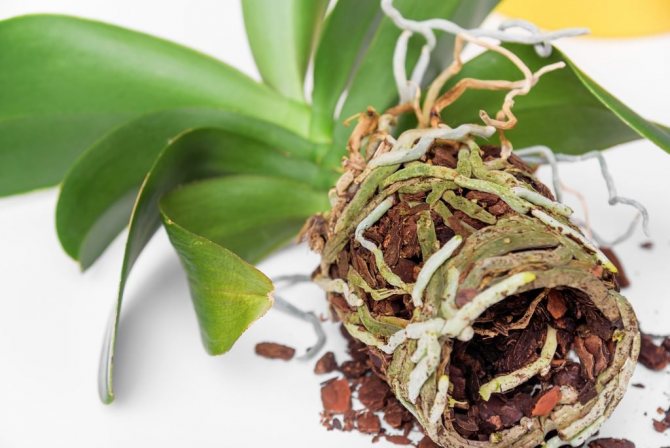

If a flower has an increase in the number of aerial roots, this also signals a lack of humidity in the room. If spots, bumps, ulcers appear on the plant, this indicates the presence of infectious diseases.

